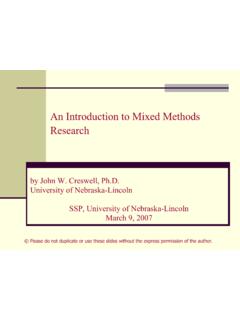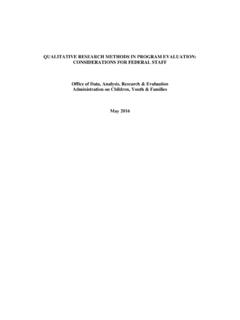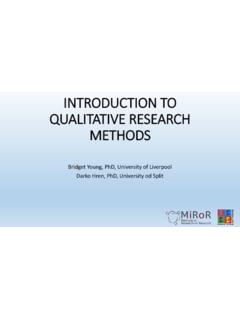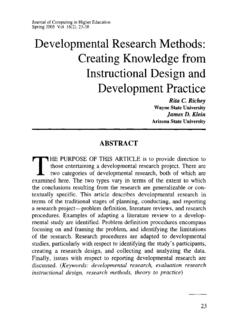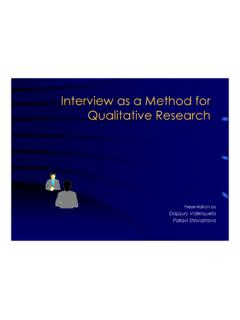Transcription of Healthcare Research Methods
1 CHAPTER 231 Healthcare Research MethodsBernadette Howlett, PhDINTRODUCTIONR esearch Methods and statistics are foundational concepts for evidence-based practice (EBP). This chapter was written with the expectation that you have taken courses at the undergraduate level that address both Research Methods and statistics. We recommend that you have books related to these topics nearby as you read this chapter. Furthermore, we recommend having references regarding statistics and Research on your bookshelf throughout your career. We have found two types of books to be particularly useful with this subject matter: a dictionary of statistics/ Research terminology and a dictionary of epidemiology. Different degree programs offer varying amounts of instruction on these topics. We have written this text with the assumption that you are taking a course in EBP early in your health professional degree program.
2 If you have had multiple courses in Research and statistics, you might be familiar with much of the material in this chapter. Another piece of advice we have for you is to know people who specialize in Research and statis-tics. It will help you in your professional program and in your career if you know people who have specialized knowledge in these fields. Just as you work with a team of Healthcare providers from dif-ferent disciplines, we recommend that your teams include people with these backgrounds. You might find a classmate or colleague who has worked as a Research assistant. Your college, university, or hospital most likely has an office of Research . There might even be tutors on your campus who can help you grapple with any concepts you encounter that are new or unfamiliar. We encourage you to identify the resources and people available to you wherever you go as a student and as a and statistics tend to be areas in which practitioners and students feel hesitant.
3 This is un-derstandable. Each of these domains has numerous degrees and specialties. Full proficiency in these subjects requires advanced education; it would be unrealistic to ask every Healthcare provider to also achieve an advanced degree in statistics and 311/10/2013 11:27:32 AMAccording to the qualitative perspective, knowl-edge comes from the internal reality of the individual or group, whereas the quantitative perspective views knowledge as coming from an external, measurable reality. Naturalistic researchers usually view reality as fluid and ever-changing, whereas positivistic re-searchers tend to view reality as fixed and unchang-ing. Many researchers fall in between these two positions and combine qualitative and quantitative Research strategies. Combining qualitative and quan-titative perspectives is referred to as mixed-method Research . Table 2 1 compares the fundamental distinctions between naturalistic and positivistic re-search.
4 Few studies fall strictly within one than likely you are familiar with positivis-tic Research , the type of Research that quantifies observations and makes predictions about popula-tions based on samples. The majority of biomedi-cal Research falls within the positivistic domain. We will briefly discuss naturalistic Research and give some examples of its application in health care. However, this text focuses mainly on Research in the positivist domain because of its predominant role in making health decisions. This emphasis on positivism does not diminish the importance of clinicians understanding qualitative Research . qualitative Research can expose layers of mean-ing and significance that cannot be detected by another in Research . However, avoiding these top-ics can place you in a dependent you avoid Research and statistics, you will have to rely on the authors of information sources re-garding the trustworthiness of the information they provide.
5 One of our goals is to give you the tools to avoid such dependence. In fact, we have already mentioned one of the best tools to use teaming up with people who have Research and statistics knowledge. Furthermore, with time and experi-ence you will become a resource to others. You will be able to share the knowledge and skills you gain from learning EBP with classmates, fellow clini-cians, and with your this chapter, we focus on the most common Research concepts found in Healthcare literature. Many of the concepts fall under the category of biostatistics ( , statistics applied to biological Research ).1 Some authorities refer to statistics ap-plied to medical Research as medical For the sake of simplicity, we use the term biosta-tistics to refer to medical statistics in this no means can we cover every concept in biostatistics in this chapter. However, as with the rest of health care, biostatistics is an area that re-quires lifelong learning.
6 Just as you commit to gain-ing knowledge about health care throughout your career, you will need to continuously grow your knowledge about statistics and Research . You will need to commit a little bit of time on a regular basis to these PARADIGMSThe two major Research paradigms are naturalis-tic, also referred to as qualitative , and positivis-tic, which is also known as quantitative. For the purposes of this chapter, the term qualitative is used interchangeably with the word naturalistic. Positivistic and quantitative are similarly two paradigms of qualitative (naturalistic) and quantitative (positivistic) Research represent different philosophical perspectives regarding knowledge, the design of Research , and the types of data interchangeability is a matter of much debate among Research theorists. In addition to the termi-nology we have selected, the designation of two Research paradigms has been debated.
7 As Pope and Mays explain, The differences between quali-tative and quantitative Research [sic] are frequently overstated, and this has helped to perpetuate the misunderstanding of qualitative Methods within such fields as health services. 3(p. 5)However, these debates are well beyond our purposes here. Because our intended audience is beginning practitioners, we leave the fine points of Research philosophy to other courses and texts that prepare you to perform an aside, we hope someday you do perform Research , because there is no better way to learn about a topic than to actively engage in it. 32 | Part I | Foundations oF EvidEncE-BasEd 321/10/2013 11:27:32 AMa survey or other qualitative re-search allows us to examine increasingly complex questions and is open to all possible answers to a question, not simply predetermined answers (which are examined in a quantitative study).
8 It is invaluable for you to understand qualita-tive Research so that you have the skills to assess the quality of a naturalistic study (such as a case report). A foundation in evaluating qualitative re-search will, for example, give you tools for con-tending with the marketing tactics of companies that sell health-related products to clinicians and to patients. Perhaps of greater value is the perspective qualitative Research can offer regarding the experi-ences of individuals and groups with health prob-lems and with the Healthcare system. qualitative Research has an advantage in this arena due to its holistic focus, which includes the individual and social context, emotions, perceptions, actions, be-liefs, values, and interactions of patients with their ( qualitative ) ResearchNaturalistic Research emerged from the social sci-ences, primarily from anthropology, as researchers recognized the need to understand and describe phenomena experienced by people as well as the nature of the people being studied.
9 Creswell offers the following definition: qualitative Research is an inquiry process of under-standing based on distinct methodological traditions of inquiry that explore a social or human problem. The researcher builds a complex, holistic picture, an-alyzes words, reports detailed views of informants, and conducts the study in a natural (p. 15)Table 2 1 Characteristics of qualitative and Quantitative ResearchNaturalistic/QualitativePositivi stic/QuantitativeQuestionsOpen-endedFocu sedFocusLived experiences of individuals, groups, or cultures that reveal meaning and significance of phenomenaCausal relationships or statistical differ-ences that explain or predict phenomena, measuring effects of interventionsSamplingSmall, purposeful, and sometimes emergent selection or serial selection of participantsLarge, preferably random samples blinded to the interventionSettingNatural, uncontrolled; studied as part of the researchLaboratory or controlled by design of researchDataObservation, artifact, textual, visual, field notes, audio recordings, includes data from researchers as well as participantsNumerical, measurable, objective data collected from subjects onlyReasoningTypically inductive, seeking descriptionsTypically deductive, seeking predictionsAnalysisThematic, narrative, content-analytic proce-duresDescriptive and/or inferential statisticsRole of researcherActive engagement with participants and phenomenon; researcher is one of many data sources within the studyNo or minimal engagement with par-ticipants and phenomenon.
10 Subjects and instruments are the sources of data, not researchersDesignEmergent, guided by data as study proceeds, utilizing no interventionFixed, predetermined, utilizing one or more interventions Chapter 2 | Healthcare Research Methods | 331/10/2013 11:27:33 AMThe amount of qualitative Research performed varies by Healthcare discipline. Nursing Research , for instance, includes more qualitative publications than other Healthcare fields. For example, a search of the Internet using the phrase, qualitative re-search in nursing produced 849,000 hits, whereas a search for qualitative Research in medicine re-sulted in 7,330 hits. Furthermore, the results of the above search led to qualitative nursing Research publications that dated back to 1986, whereas those related to medicine dated back to 1999. According to Risjord,4 qualitative Research became popular among nursing researchers in the early 1980s.










